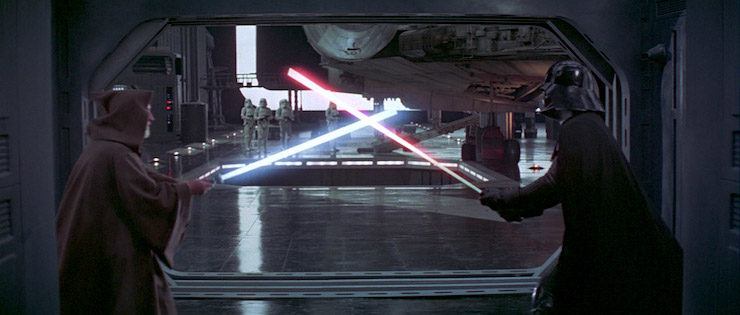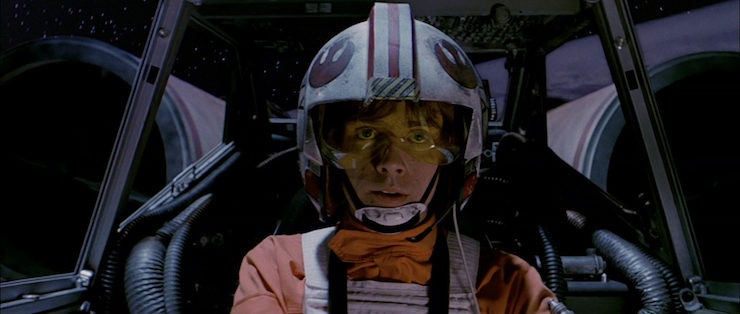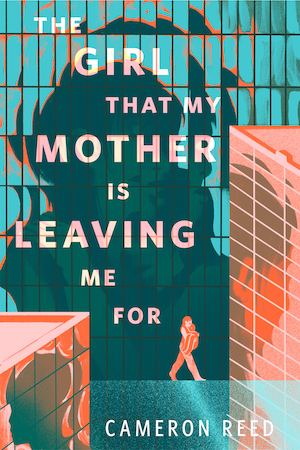In 1975, a little movie about big trouble in a New England resort town came along and changed American cinema. That movie was Jaws, the Steven Spielberg-directed shark thriller that’s credited with inventing the summer blockbuster. Not only was Jaws a runaway box office success, but it was a bit of an anomaly in the fabric of 1970s American filmmaking. After all, from a certain point of view, the ‘70s can be understood as the American art house decade; in no other period did auteur-driven movies—such as The Godfather, One Flew Over the Cuckoo’s Nest, and The French Connection—find so much mainstream success. Jaws, though, gave audiences something totally different, and people came in droves to see it. And then, just two summers later, audiences’ desire for big budget, genre-drive movies was cemented when Star Wars took the entire world by storm.
But for all their similarities, Star Wars did something extraordinary that Jaws did not.
There’s a part of George Lucas that, undoubtedly, shares Steven Spielberg’s pop sensibilities. Like Spielberg, Lucas finds tremendous influence in classic pulps—sci-fi, adventure, fantasy, even romance. And while Spielberg and Lucas both possess an unparalleled devotion to the craft of filmmaking, Lucas’s sensibilities were also rooted in the world of independent, arthouse cinema. As much as he was influenced by Flash Gordon, Lucas found equal inspiration in Akira Kurosawa; swashbuckling adventures like Robin Hood clearly captivated Lucas, but so did Buster Keaton’s silent movies. This duality of influences was clearly on display when Star Wars was ruling the box office in the summer of 1977—and the impact it had was profound.

One of the most memorable scenes in A New Hope is the lightsaber duel between Obi-Wan Kenobi and Darth Vader. And it’s a scene that is lifted—in a loving way—from Kurosawa’s masterpiece, Seven Samurai. For Kurosawa, violence was often blunt, brief, and brutal. This is where you see Lucas stray from the swashbuckling tendencies of, again, something like Robin Hood, where sword fights were fanciful and oftentimes infused with a touch of levity. Seven Samurai offered a wide-angle portrait of two swordsmen, fighting to the death, as did the Vader and Kenobi duel. What comes to the forefront is the emotional intensity of the moment, balanced alongside the life-or-death stakes of the confrontation.
That focus on the emotional resonance coupled with the visual language of Kurosawa—who, like Lucas, was heavily influenced by silent films—had a direct impact on movies in the years to follow. Ridley Scott, upon seeing Star Wars, all but altered the entire course of his career. “I canceled the film I was going to do, after I saw Star Wars,” Scott said in an interview with Deadline.com. Instead, he devoted his energy into making a sci-fi movie—a little movie called Alien. You can see the language of Star Wars written all over that movie, from its wide shots, its intimacy and, especially in its use of sound. Then, five years after he made Alien, Scott made Blade Runner, which again draws from the Star Wars aesthetic. Like the duel between Vader and Kenobi, the rooftop fight between Rick Deckard and Roy Batty is all about wide-angle shots and the deep emotion of the moment. Gone are the larger-than-life qualities that dominated sci-fi in the ‘60s, replaced with something more personal, more human. And those flourishes are pervasive to this day, even in the Star Wars universe. In this past season of Star Wars Rebels, Obi-Wan Kenobi is faced with another duel, this time against his foe of many years, Darth Maul. It’s a quick, emotionally charged moment, reminiscent of this scene from Seven Samurai:
But Lucas’s inspiration for Star Wars is hardly limited to Kurosawa and those moments of quiet intensity. Because Star Wars is also a space opera, and there’s no shortage of bombast in Lucas’s epic. Lucas’s space battles, painfully constructed with sets and models, drew their realism from a string of war films that captured World War II dogfights. Lucas drew heavily from movies like The Dam Busters and 633 Squadron. Both these movies captured a sense of realism in how pilots communicated, their attack formations, and what it was like to inhabit the cockpit of a fighter plane. Lucas took those elements, dropped them into space, and, with his masterful use of images and sounds, gave audiences a thrilling scene that would be mimicked for years to come. From The Last Starfighter all the way to Guardians of the Galaxy, countless movies have benefited from the ground Lucas broke in the climax to A New Hope—a climax that has its roots in movies that predated it by two decades.

What matters most, in the end, is execution; the magic rests in how the story is told. And with Star Wars, Lucas rewrote the playbook on how a science-fiction/fantasy story could be told, by drawing on a pastiche of influences and infusing his inspiration with an indelible style and voice. Lucas established a new template on a massive scale, and countless filmmakers have since looked to Star Wars as a guide. And when they do, they inevitably discover a rabbit hole that travels through a robust swath of cinematic history.
From technical achievements to helping establish the blockbuster’s role in American cinema to broadening the scope of influence on future generations of filmmakers, there’s no shortage of ways Lucas changed American cinema—and there’s no shortage of reasons to continue to celebrate his achievements 40 years later.
Michael Moreci is a comics writer and novelist best known for his sci-fi trilogy Roche Limit. His debut novel, Black Star Renegades, is set to be released in January 2018. Follow him on Twitter @MichaelMoreci.










A comprehensive list of everything new introduced by A New Hope is surprisingly lengthy. I’m no film critique expert but as a long-time fan I’ve heard about the lived-in feel, the special effects of course, the acting which isn’t all that terrible and takes the story just seriously enough while still conveying fun, the cantina scene, the unexplained throwaway background details, the fast-paced story and frequent action, the western motifs, the whole concept of the Force, the best villain of all time, the surprising reliance on robot characters to carry the story in places and provide comic relief (Wall-E really wasn’t taking that big a chance, with this precedent), and the killer soundtrack of all soundtracks. I’m probably forgetting something. The Academy Awards had to acknowledge its greatness, with all its many nominations. A seemingly endless list of people in Hollywood who cite it as an influence, and as seen immediately in movies like Alien and Close Encounters, and all across the four decades since. As a kid at the time it was frustrating to me that nobody else could do anything even approaching it in quality. Just the fact that it made everything else look a like a cheap imitation for at least the first decade speaks to what it was. We’ve not seen anything with that kind of impact again since, not even Jurassic Park or Avatar as big as they were.
Disney should be ashamed of ignoring most of the 40 years of work. EU forever!
Thanks for this :) I came into fandom because of the Special Editions so I grew up in a post-Star Wars world. So I suppose it says something that even though despite the fact that Star Wars wasn’t ‘new’ and many movies had taken its lead, that it blew me away so thoroughly.
Wow, this was very helpful and it helped me with my homework. ;]
You not only ‘GOT IT’ – you have the skill and craft – the artistry – to pass it on.Opening the eyes of others who need a friend to get them through the door – out of the lostness of being stuck-in-the-mudness of an old worn out mindset (IMAGINATION) – AND INTO a DIFFERENT / NEW UNKNOWN DIMENSION is no easy task.YOU – MY FRIEND HAVE GROWN THAT MAGIC.LUCAS WAS ABLE TO INTRODUCE AND SHARE WITH THIS OLD WORLD HIS IMAGINATION – so profound and immense – it blew away everything that came before.IT BEGAN A NEW DIMENSION THAT GREW DIFFERENT CREATIONS – THE YOUTH WERE GIVEN A REAL AND TRUE FREEDOM – THE FREEDOM TO TEST AND TRY THEIR OWN INDIVIDUAL IMAGINATIONS.LUCAS HAD THE BALLS TO GIVE BALLS TO EVERYONE.
HE DARED SET US FREE – BECAUSE HE DARED TO BE FREE.HE DID THIS ALL ON HIS OWN / ALL BY HIMSELF.TALK ABOUT SUPER-HEROES this was one.FEW EVER HAVE LIVED ON THIS PLANET GIVING IT SUCH A POSITIVE INVENTIVE PUNCH – EVERYTHING CHANGED.ONLY THE GREATEST ARTISTS – THE GREATEST CREATORS – THOSE SPIRITS THAT HAVE GONE BEYOND WHAT IS KNOWN BY DARING IT ALL – TO BRING BACK A TREASURE – WHICH THEY THEMSELVES HAVE BECOME – TO GIFT THIS MUNDANE WORLD WITH.
LUCAS PUT THE PAST INTO THE PAST- HE PUT THE DEAD TO REST AND BEGAN A PROCESS THAT GREW DIFFERENT PEOPLES WITH DIFFERENT IMAGINATIONS – BEINGS never existing before —THIS MASTER’S TOUCH.
THANKS.